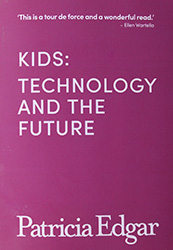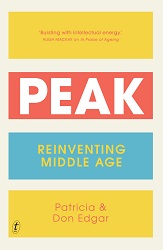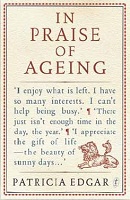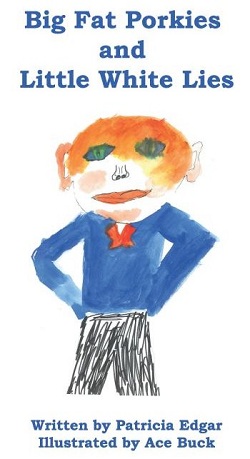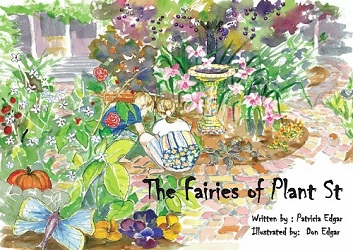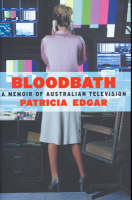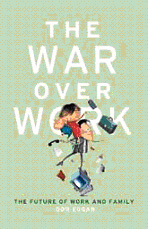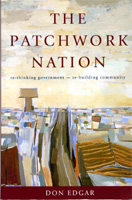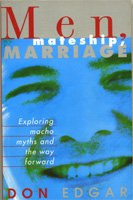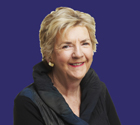
Patricia Edgar & Don Edgar

'I want to say what I like, when I like, to whom I like'
April 21, 2002
Patricia Edgar chuckles as she recalls the day in the mid-70s that she and former publisher Hilary McPhee spent photographing two bearded and hairy naked men in a series of coy, "feminine" poses.
The photos, which spoofed a series of stereotypical images taken straight from contemporary advertisements and newspaper articles, appeared in the duo's book Media She, an analysis of advertising and media images of women.
"Hilary and I spent a lot of the day putting their hair in rollers. It was hysterical," recalls Dr Edgar. "We took a lot of the pictures under the road bridge on the LaTrobe University campus. If we'd been caught, I don't know what would have happened to us."
Walking over to the bookshelf in her Fitzroy office, the outgoing head of the Australian Children's Television Foundation pulls down a copy of Media She, and opens it at a photo of a bearded man with his long hair wound up in curlers. "How to do your own hair so it looks as though you didn't," reads the caption.
On the
next page, the same bloke is lying on a bed and wearing nothing but a smile.
"I hated being photographed until I took off 27lb", says its caption.
He and another bearded male also appear in a series of nude and semi-nude
"page-three girl" poses.
Still regarded as a landmark text in the areas of both women's studies and media studies, Media She, published in 1974, is an artefact from a career that pre-dates Patricia Edgar's 20 years at the helm of the Australian Children's Television Foundation (ACTF).
Certainly Dr Edgar remains best known, both here and internationally, as the mother of quality Australian children's television programming, the architect of acclaimed programs such as Lift Off, Round The Twist and Yolngu Boy, and the driving force behind an organisation whose award-winning programs are sold to 100 countries. But the former academic could also be described as the mother of Australian media studies.
In 1966, when she was a 29-year-old teacher with two toddlers and a part-time Council of Adult Education job, Dr Edgar accompanied her husband, Don Edgar, to Stanford University, in the United States, where he had enrolled in a sociology doctorate. She was delighted to find that the university had a masters degree in film and communication studies. In 1960s Australia no university had considered film or the "mass media" worth studying.
She enrolled "out of sheer interest" rather than career ambition: "I loved movies."
On her return in 1970, she discovered that the newly established LaTrobe University had a centre for the study of media and communication, the first of its kind in Australia. Dr Edgar made contact, pointing out that she was the only person in Australia with any tertiary qualifications in this new field. She was hired, began developing courses and was soon running the department.
The trip to California also changed Patricia Edgar's life in more personal ways. "I always thought there was something wrong with me," she recalls. "I couldn't understand why I was different from friends of mine. The first day I set foot in Stanford, California, I knew there wasn't a single thing wrong with me. It was all wrong back home."
The young teacher's problem "back home" was that she was a feminist fish in a conservative, pre-feminist pond. It was only 1966, three years before the first legal ruling on equal pay for women, and four years before Germaine Greer burst on to the scene with The Female Eunuch . Yet Patricia Edgar was living in a relationship resembling an equitable 2002-style marriage. She had a job, albeit a part-time one, and a husband who shared household tasks and the care of their two daughters, Susan and Lesley.
"Don and I worked together, we always shared everything," she recalls. "Occasionally people would tell me I treated Don very badly because I insisted that he did anything I did, whether it was cook the dinner, or clean up, or look after the kids. But he didn't feel that.
"Don's father had died when he was 10, so he was brought up in a single-parent household. His mother worked, there were five children, he was the oldest boy and he had to come home from school and contribute. He was used to seeing a woman work, there was nothing odd about it."
Outside the four walls of home, Patricia Edgar always felt the odd one out. She couldn't understand why all her married friends seemed happy to turn their back on their previous identities and embrace their "new" roles as wives and mothers. "In those years the assumption was that you deferred to your husband."
The youngest of three daughters, Dr Edgar had grown up viewing her father's life as more interesting than her mother's. Her father had retired at 40 from his job as an optometrist and moved on to public life, sitting on the Mildura city council, and driving the new movement for regional art galleries.
In fact, young Patricia Edgar had been so determined to live her father's life that she had been initially reluctant to marry Don Edgar. The pair had met in Geelong, where she was in her first year as a teacher, while her husband-to-be was in his second.
"Don was very single-minded. He was sure that I was the woman for him," she says. "But I wasn't so sure. I remember grilling him (about roles and expectations).
"My mother was a remarkable woman but she played a domestic role. I did not want to live the sort of life that I had seen [her] live."
Life at Stanford University was a revelation. The academics lived in community housing, where people minded each others' children. Other academic couples were sharing family and work in the same way that she and her husband Don did.
Suddenly Patricia Edgar felt normal.
More than 30 years later, Dr Edgar is happy to reflect on a partnership that has been thriving for 42 years. Given Don Edgar's background, it's not so surprising that the Edgars' relationship survived the heady days of 1970s feminism when so many marriages cracked under the strains of women's sudden demands for equal rights. But it remains impressive that the Edgar marriage has managed to sustain two big large public careers without strain or rancour.
Timing, Patricia Edgar says, has been the key to balancing the competing demands of family and careers. When their daughters were younger, both worked as academics.
"A lot of my teaching was in the evening. And working in a university gives you a degree of freedom that jobs like this don't."
In 1980 and 1981, when both partners took on their big demanding start-early, finish-late jobs - Don Edgar's as head of the Australian Institute of Family Studies, and her own, at the ACTF - their daughters were 16 and 18 and finishing school and beginning university respectively.
"That was when we started putting in the really long hours away from home. People would say, 'You never see each other' but we would get together in the evening and at weekends. And the other thing is that we're in related fields, so we've always had things of interest to talk to each other about."
The Edgars' morning ritual is symbolic of their emotional and intellectual bond. "Don opens his eyes and he's out of bed. I am slow to get moving in the morning," says Dr Edgar. "For our entire married life, Don has brought me a cup of tea in bed. So I'll have two cups of tea, and then I can communicate. And he reads me the paper while I'm waking up."
This routine, which began once their daughters left home, takes about half an hour. "He goes through and pulls out the things of interest." That will be the headlines, the main news stories - anything about education, or media, or social justice. Then the opinion pages.
"By the time I leave, I have a good idea of what the issues are for the day."
Such domestic stability has formed a solid support for a working life fraught with conflicts.
First there were the regular battles involved with being the the first chairman of the first media studies outfit in an Australian university - and a woman to boot.
"There was huge opposition within the university hierarchy," Dr Edgar recalls. "They said film is not a discipline worthy of study in a university. They said I had an American degree and it was inferior because I didn't get it at Oxford or Cambridge. And I was one of the few women to be running a department, and that was pretty unusual. These guys in those days... the notion of a woman in the room, even, was traumatic."
Then, in 1976, and as a member of the Victorian Government's new Equal Opportunity Advisory Council, Dr Edgar resigned after a row about the council being asked not to raise matters that might "embarrass" the then Premier, Dick Hamer.
Thereafter, in her four years as chair of the committee advising the Australian Broadcasting Tribunal on children's programs and in her 20 years as head of the Children's Television Foundation, Dr Edgar fought a war with the major networks, many of whose representatives still argue that children would rather watch blockbuster movies than "politically correct" and imaginative children's drama. Meanwhile, she consistently crossed swords with rival independent television producers who wanted the foundation to stop making its own programs and concentrate on lobbying for the independent sector as a whole.
Simon Townsend, former producer of the '80s and '90s show Simon Townsend's Wonder World once described her as "megalomaniacal". Others in the industry have nicknamed her "the tank".
But the biggest battle of Pat Edgar's life had nothing to do with television or its politics. It began, in 1976, with an apparently innocuous event. She lost her voice. It would break, disappear, and then return sounding, as columnist Phillip Adams said, "like a buzzsaw cutting through ironbark".
"It sounded like I was being strangled, and like I was having a nervous breakdown," she says.
"Nothing in my life has equalled it. Not even breast cancer (which was diagnosed quickly and treated with a partial mastectomy in 1988). It was like a death. I suffered incredible grief."
Throughout, Dr Edgar kept on with her work as an academic and a member of the Australian Broadcasting Tribunal's advisory committee on children's television. She didn't even tell people about the problem. "Mostly I didn't. They just thought I had an odd voice."
After a long period of killing uncertainty and conflicting medical opinion, a Sydney doctor diagnosed her ailment as "spasmodic dysphonia", a rare neurological syndrome. After four years, including repeated trips to a speech pathologist in Los Angeles, she was cured.
In the meantime, she had to change her whole personal style in order to fight the disease and save her voice.
"I had to become less 'talky'," she laughs.
"People had found me intimidating because I talked so much. Then they found me intimidating because I would sit there and look at them."
Twenty years after being cured, Dr Edgar's voice is, as she puts it, her "weak spot". But having sensitive vocal cords hasn't affected her readiness to express her views at length.
The children's television supremo makes much of the fact that she has mellowed over the years. Yet two months short of her stepping down from the ACTF, it appears she is ready to go one more round with "the Johnny come latelies" of the children's television-making world.
One of her plans for retirement, besides travelling, working on a BBC series as a producer, and spending more time with her daughters and grandchildren, is to write a no-punches-pulled history of children's television in Australia.
" I have 25 years of files," she says.
"The nature of the industry has changed. There was a kind of old guard, of which I was a part, who worked to create this industry to serve cultural purposes and to fill a gap. There are people who have come in [to the industry] who were never part of that struggle, who have ridden in, and who really do believe the world owes them a living.
"I have lost tolerance with being discreet. I want to say what I like, when I like, to whom I like."
